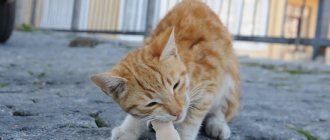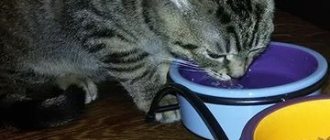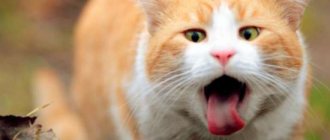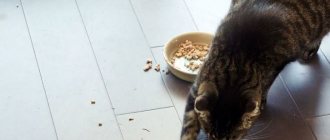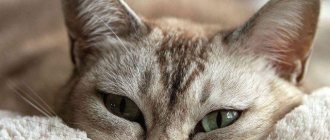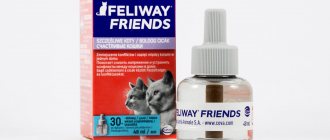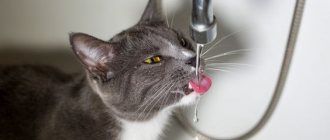22282Administration
1
What should an owner do if his cat doesn’t eat, just drinks water and sleeps? Firstly, be glad that the animal at least drinks. After all, cats are 70% water. If you reduce this rate, say, by 10%, death is guaranteed. And secondly, if the cat doesn’t eat anything and just sleeps, that’s also good. Sleep is sometimes the best medicine.
But, be that as it may, when a pet does not eat for several days, at this pace it can last up to a maximum of 5 days.
Problems with the mucous membrane
This condition is sometimes caused by small particles of food or objects that get stuck in the throat or esophagus. If the particles have sharp edges, then there is a high probability of injury to the mucous membranes, which causes pain and severe discomfort. Naturally, in this state the cat is unlikely to dream about food.
In addition, a foreign body in the stomach or intestines causes difficulty in moving food. Food stagnates and is not digested, and begins to rot. Putrefactive bacteria can lead to acute poisoning, so your pet should be seen by a veterinarian as soon as possible.
Trying to remove the stuck pieces on your own will aggravate the pain and, most likely, will not bring results. The only way to alleviate the condition before the doctor arrives is to drink plenty of cold water.
Anorexia
Catastrophic weight loss in the body can be caused by problems with digestion or the presence of worms in the body. This is especially common in kittens.
The baby's body is still developing, so it is natural that some food is not fully absorbed, creating discomfort in the intestines. For this reason, the baby may refuse food.
What to do? Give neutral food, boiled or well-heated, restorative broths and always fresh water.
If worms have settled in the esophagus, they poison the kitten’s blood with the products of their vital activity. This causes general malaise and weakness, and as a result, loss of appetite and lethargy.
Mandatory measures are to give an anthelmintic in exact accordance with the weight and age of the kitten (for example, Drontal, Milbemax tablets, Profender, Stronghold drops). Next, observe your pet’s urine and stool. Insertion of parasites is easy to distinguish in the urine, and the helminths themselves can be found in the stool. Even if there are no worms in the intestines, precautions will not be unnecessary.
Kidney pathologies
One of the most common diseases in older cats is kidney problems. This is especially true for castrati. We are talking about urolithiasis, in which uroliths form in the kidneys and/or bladder. These are stones based on uric acid salts. If they looked like sea pebbles smoothly rounded with water, they would hardly pose a danger to the life of the animal. The problem is that uroliths have very diverse shapes and sharp, almost cutting, edges.
Even when urinating, when the bladder contracts, they cause the cat unbearable, cutting pain. Because of this, any “small” trip turns into real torture for the animal. Urine takes on the rich color of beet juice and is released in small portions. The cat wheezes and meows loudly whenever he goes to the toilet.
But it’s much worse if stones have formed in the kidneys. Pain in this case can occur at any time, overtaking the animal suddenly. Their intensity is such that so-called renal colic begins. If they are not stopped with powerful painkillers, another attack can lead to the death of the cat from acute painful shock. More details in the video below:
Treatment of urolithiasis depends on the severity of the case, the number and location of the stones, as well as the immediate condition of the animal. If there are few uroliths and they are small, the veterinarian (when the clinic’s equipment allows) can use an ultrasound machine to destroy them. When the animal's condition is severe, surgery is recommended. When the cat may not survive it (he is too old), maintenance therapy is prescribed, which involves the administration of painkillers. Unfortunately, in the most severe cases, euthanasia is recommended.
But kidney problems are not limited to urolithiasis alone. This includes a variety of nephritis, nephrosis, pyelonephritis, renal lipidosis and similar ailments. If the disease has been advanced (and in the case of old cats this often happens), the morphofunctional structures of the organ are seriously disturbed, the excretory system cannot fully perform all the functions assigned to it by nature, which is why chronic renal failure develops. Chronic renal failure is an insidious thing. Its symptoms are quite extensive:
- Constant and very strong thirst, copious and increased urination.
- Progressive weight loss.
- Vomiting, and the vomit may smell unpleasantly of ammonia (in advanced cases).
- Loss of appetite.
- Convulsions and other neurological seizures.
- Weakness, apathy, possibly lethargic state and coma.
- Pale gums.
- Diarrhea.
- The appearance of blood in vomit and urine, as well as stool. Melena, a tar-black stool, may appear.
- Formation of deep, non-healing ulcers with jagged edges on the skin. By the way, skin diseases of old cats are very often caused by the poor condition of their kidneys and liver.
Why does such a pronounced clinical picture develop? The reason is severe intoxication caused by complete or partial inoperability of the excretory system. Unfortunately, methods for treating this pathology have not yet been developed. It all comes down to maintenance therapy to at least partially relieve intoxication, as well as to the prescription of painkillers that alleviate the cat’s condition during attacks of pain. We strongly advise against bringing kidney disease to chronic renal failure!
In addition, very old cats may experience simple urinary incontinence. The animal often wakes up in a puddle, its fur smells unpleasant, and it becomes tangled. As a rule, this can no longer be treated. The owner of such a cat will have to wash his pet more often and try to ensure that he does not drink too much at night.
Gastrointestinal diseases
Problems with the gastrointestinal tract in cats are determined by the following signs:
- vomit;
- diarrhea;
- discharge containing mucus;
- bloating;
- hard and tense stomach;
- strong odor from the mouth.
Among the most common problems is gastritis or the accumulation of hair in the stomach.
It’s not difficult to deal with a hairball: drinking plenty of fluids and special medications that help remove hair from the stomach will solve this problem (for example, “Phytomins”).
But gastritis is somewhat more complicated; its treatment requires time and effort. At the initial stage, it is necessary to give the cat boiled water and rice water. Then they use activated carbon diluted in water and medications prescribed by the doctor (most often these are stomach drops, Almagel). Food should be low-fat and exclusively unsalted.
Why might a cat refuse to eat?
A cat can refuse to eat for an incredible variety of reasons. Most diseases can begin with this common symptom.
If your cat has one of the following signs, then you better go to the veterinarian without delay:
- lethargy
- increase in body temperature
- vomit
- diarrhea
- constipation
- difficulty urinating or no urination at all
- discharge from the nose and/or eyes
- open mouth breathing (“like a dog”)
The reasons that a cat is not eating are not necessarily related to illness. Lack of appetite in cats can be influenced by various factors:
- The cat has already eaten))). Check to see if he ate something secretly from you, or if he opened the door of the cabinet or even the refrigerator. This also happens. Cats can be very inventive and persistent in their desires. Interview relatives - perhaps someone has already fed the pet.
- Any change in the type and quality of feed. Cats are often very sensitive to the composition of food, its consistency, temperature, and smell. And even with a small change, they may not touch the food. Sometimes it can even be the same ready-made food, but from a new pack. Or the same food, but with a slightly different taste. Or instead of a can of jelly, you bought pate. Not to mention homemade food, where it is impossible to keep the ingredients identical. Therefore, think about what might have changed over the last 1-2 days in your pet’s diet. The transition from one type of food to another should be carried out gradually, over 7-10 days, by mixing the new food with the old one.
- Changing the external environment in the apartment. Has the bowl been moved to a place that is not comfortable for the cat? Have they placed something unusual in the place where the cat prefers to eat (a large bag, a broom).
- Stress. Cats are very sensitive to stressful situations: traveling with them somewhere, the arrival of strangers in the house, the appearance of a robot vacuum cleaner, even the smell brought on clothes can provoke a reaction from the mustachioed pet and lead to a decrease or lack of appetite.
- Features of sexual behavior. During the period of active sexual hunting, both male and female cats may experience a decrease in appetite. The reproductive instinct overcomes basic physiological needs

